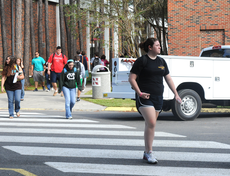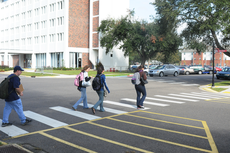Nicholls police have increased safety efforts and communication across campus in lieu of two recent motor vehicle accidents involving pedestrians.Student Information sent an e-mail to students, faculty and staff about the importance of safety while driving and walking on campus. Craig Jaccuzzo, director of University Police, said the e-mail has opened a dialogue between the campus community and his department.
“It allowed individuals to open up to me and tell me things they saw on campus,” Jaccuzzo said. “It gave me the opportunity to see things that I didn’t know were areas of concern in the eyes of those who walk, ride a bike or drive.”
As part of street improvement projects across campus, pedestrian crosswalks were widened and reflective speed bumps were installed at each intersection and crosswalk. Also, the speed limit of 15 miles per hour was posted at each entrance to campus.
In areas of high pedestrian and vehicle traffic, a network of video cameras was installed on University buildings to provide evidence support to officers who report to campus traffic incidents.
Jaccuzzo said the inattentive pedestrians and drivers in areas of high vehicular and pedestrian traffic caused two accidents in two weeks. He also said the use of mobile devices is the main cause.
On Oct. 8, a driver struck a female student along Ordoyne Drive in front of the Family and Consumer Sciences Building as she veered her car too wide to enter a parking space. University Police issued the driver a summons for careless operation as a result of the driver not paying attention to the pedestrian.
On Oct. 12, a driver struck a male student as he was entering the crosswalk at Leighton Drive in front of the Student Union. University Police discovered the male student was unaware of the approaching vehicle because he was listening to an iPod and playing with his cell phone while walking across the crosswalk. As a result, the driver was not issued a summons.
Even though inattentiveness was a factor, speeding did not contribute to either accident, according to Jaccuzzo. “If the vehicles were driving at a high rate of speed, there would have been more moderate or severe injuries.”
Loni Falcone, family and consumer sciences senior from Gretna, said she goes back and forth from the Union to the Ellender Memorial Library at the Ellendale Drive crosswalk cautiously.
“People can’t always see you because of all the cars parked,” Falcone said. “People zoom by, but I continue walking. I try to stop as quickly as I can to avoid traffic.”
Another concern for University Police is crosswalks along Audubon Drive near John L. Guidry Stadium, Babington Hall and Ellender Hall, and students who park vehicles along Bowie Road before walking onto campus. Drivers traveling at higher speeds along these roads may cause more severe accidents with pedestrians who frequently cross or walk along these roads.
“Those areas have the potential for a devastating incident,” Jaccuzzo said.
Unlike Acadia, Madewood, Glenwood and Ellendale Drives, which are located in the campus interior, Audubon Drive and Bowie Road fall along the campus exterior. These roads are state or city managed streets and experience commuter as well as University-related traffic. University Police can regulate the speed of traffic on the parts of Audubon and Bowie that fall within University borders.
Jaccuzzo offered tips for driving and waking safely across campus. Pedestrians do not always have the right of way, even on crosswalks, Jaccuzzo said. Pedestrians must look in all directions prior to crossing any street on campus, and drivers need to be aware of them.
Falcone said when she walks on campus, she lowers the volume of her iPod to hear cars traveling and doesn’t use her cell phone when crossing streets. “I don’t want my iPod or cell phone to be cause for me to get into an accident,” she said.
Marcus Robertson, business administration sophomore from Thibodaux, said he has seen many drivers and pedestrians distracted when using mobile devices while traveling across campus. However, he admitted he has engaged in the same activity when commuting to campus from home or walking on campus in between classes.
“I have been distracted when using my iPod,” Robertson said. “If campus is busier, I tend to pay more attention when driving or walking.”
Jaccuzzo said anyone walking or driving through Nicholls while using a mobile device should consider accidents as a viable consequence. “When traveling on campus by foot or vehicle, it isn’t the appropriate time to use a cell phone, computer or iPod,” he said.

Students travel within a University crosswalk on Ellendale Drive between classes Wednesday. (Amanda Jefferson)








